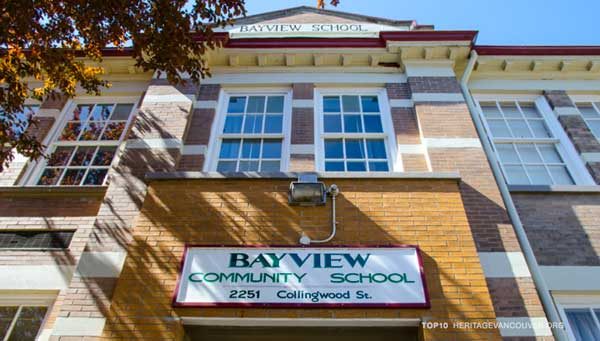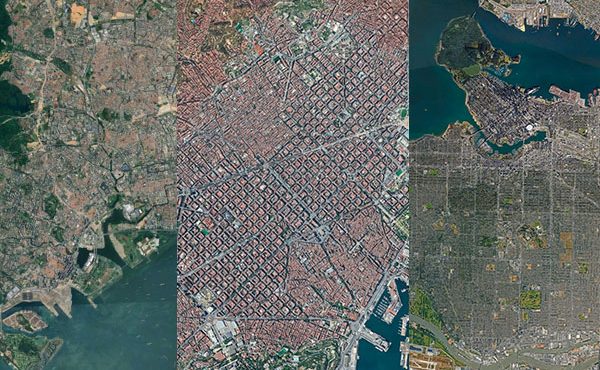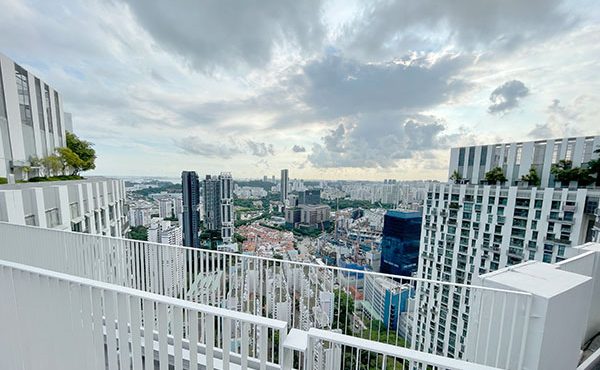Heritage Vancouver has released this year’s Top 10 Watch List. This year we are seeing particular threats to our neighbourhoods’ character, culture and history. They range from a loss of individual architecturally significant homes to single-family neighbourhoods, to the potential loss of entire communities along with those community nodes that hold them together.
Our 2016 Top 10 Watch List is:
- Bayview Community School (1913-14) – Heritage Schools
- Crown Life Plaza (1978) – Recent Landmarks
- Chinatown
- Salvation Army Temple (1950) – Community Gathering Places
- St. Stephen’s United Church (1964)
- Red Light District of Alexander Street
- Commercial Drive – Our Main Streets
- Townley & Matheson homes – Demolition Derby
- Vancouver College (1924, 1927, 1957)
- False Creek South – The ideal planning community
Chinatown, False Creek, “The Drive” and areas of the Downtown East Side are all present on this year’s list. Each represents a unique piece of Vancouver’s history and remains the heart of distinct cultural communities, yet all are also facing the same threat: development pressure.
Schools continue to be threatened as several have just been demolished in the last few months- Sir Sandford Fleming has just been announced. Churches as well continue to grapple with declining congregations and revenues, and increasing land values. As the churches are sold for redevelopment, Vancouver loses crucial community gathering space.
Complete details can be found here: http://heritagevancouver.org/top10-watch-lists/
Bayview Community School (1913-14) – Heritage Schools
2251 Collingwood Street, Vancouver, BC
The demolition of Sir Sanford Fleming School, and its replacement by a new school, has just been announced. Which historic Vancouver school is next on the hit list? Bayview Community School is a historically significant landmark in the Kitsilano neighbourhood. Built in 1913-14 in the Classical Revival style, it is one of Vancouver’s most impressive Edwardian-era elementary schools.
The Vancouver School Board’s 2016 Interim Long Range Facilities Plan proposes that Bayview will be one of the 14 Priority Projects to proceed without delay under the seismic mitigation program. Seven of the 14 schools, including Bayview, are listed on the Vancouver Heritage Register, but this does not protect them from demolition. Until the School Board undertakes heritage value assessments of the schools as part of their seismic mitigation process, they can be considered threatened. Many heritage schools have already lost.
With more creative solutions, essential seismic upgrades can be achieved without the destruction of our valuable heritage schools.
Crown Life Plaza (1978) – Recent Landmarks
1500 West Georgia Street, Vancouver, BC
The tower, pool and waterfall situated on the prominent corner at 1500 West Georgia Street function as the west gateway to the Central Business District (CBD), and are highly visible on the walking route from Stanley Park via the Causeway. Architect Peter Cardew was the project architect for this building, which was originally known as Crown Life Plaza (1978). It is currently on the City’s informal list of Recent Landmarks, and the Heritage Commission has recently recommended that the entire immediate block, including the Plaza, be added to the Vancouver Heritage Register.
There is a proposal to develop the east side of 1500 Georgia Street, involving the alteration or removal of the pool and waterfall to make way for an up-to-50-storey residential tower which would dominate the Plaza. The siting, scale, form and overall character of the new residential tower would completely alter the coherence and context of Cardew’s original design.
Chinatown
Chinatown is a unique urban cultural landscape, and its core is a National Historic Site. New buildings in the neighbourhood are required to meet design guidelines, with an aim to retain a ‘Chinatown-look.’ However, the guidelines do not address all the characteristics of the area as identified in the City’s plans and policies, and that are regarded as important to the community.
These characteristics include tangible and intangible aspects of Chinatown’s unique and authentic character, such as community and cultural activities, a diverse housing mix for affordability and an aging population, and experiences of Chinatown’s culture and heritage in urban life.
The primary threat to the character of Chinatown is new development that ignores these attributes. Outside the historic core of Chinatown on Pender Street between Gore and Taylor, the issue is not so much what is coming down, but rather what is going up. New infill developments are failing to engage with the intangible character of this important place, and may overwhelm it with out-of-scale and out-of-character developments.
Fear over the loss of Chinatown character – despite the many years of planning that has gone into it – has led to demonstrations, protests at City Hall, a petition for a moratorium on development, community organized talks, countless letters, websites started by community members, numerous news articles in major newspapers including the Globe & Mail, and a documentary film that played at the Vancouver International Film Festival.
Salvation Army Temple (1950) – Community Gathering Places
301 East Hastings Street, Vancouver, BC
Designed by architects Mercer & Mercer, the Salvation Army Temple, at 301 East Hasting Street, is one of the significant surviving Moderne buildings in Vancouver. The Temple is also one of the last opportunities in the Downtown Eastside to convert a purpose-built assembly hall to community arts and cultural space. This site is already listed on the Vancouver Heritage Register.
BC Housing issued a Request for Proposals in December 2015 for redevelopment of this property to non-market housing. Demolition of the Salvation Army Temple would mean losing an irreplaceable modernist landmark.
Since the loss of the Pantages Theatre, this is the last significant historic purpose built assembly building in the Downtown Eastside that has the potential for conversion into community cultural space.
St. Stephen’s United Church (1964)
7025 Granville Street, Vancouver, BC
This is the third year in a row that historic churches have been featured on our Top 10 Watch List. As many Vancouver churches face declining attendance, the rate of church closures is threatening the future of community heritage and gathering spaces. St. Stephen’s United Church, designed in a West Coast Modern style, opened in 1964.
In a story that is now all too common, the 150-seat sanctuary used to be full on Sundays; the congregation has now declined to less than 90 people, and only about 30 members attend the weekly service. In a few years, the church may have to close, and the building will likely be sold and replaced by mid-rise housing following the development pattern nearby on south Granville Street.
When heritage churches close, Vancouver communities lose more than places of worship, they also lose space for the countless social and cultural activities that churches host each week. With fewer places for groups to meet in our ever-denser city, more people will become isolated, diminishing our quality of life. Public places are essential to a healthy community and are a cornerstone of democracy, and our churches represent a very significant amount of the social gathering space available in our city.
Red Light District of Alexander Street
500-600 blocks of Alexander Street
Strathcona is the home of some of Vancouver’s oldest buildings, but not many of the sites on the Heritage Register are protected from demolition through heritage designation.
A unique cluster of 1911-12 buildings in the 500 and 600 blocks of Alexander Street, where the Red Light District once thrived, are threatened by potential development pressure.
Of the buildings that remain, and are known to have been brothels, only 500 Alexander Street is protected, but 514, 610, 662 and 666 Alexander Street are not even listed on Heritage Register and could easily disappear. A number of other early brothels in the area – including those run by Maria Gomez and Fay Packer – have been demolished for social housing projects.
This East End neighbourhood has suffered from the absence of co-ordination in community planning. While Strathcona south of Hastings Street has undergone carefully-managed change, north of Hastings Street is prey to redevelopment. Though the “Downtown Eastside Plan” has a policy to consider a Heritage Conservation Area for Japantown, heritage sites throughout the area bounded by Main Street, Hastings, Heatley Avenue, the Port and the CPR tracks are facing the threat of demolition.
Heritage Vancouver supports the recognition of the Red Light District through additions of these sites to the Heritage Register, and zoning and planning improvements for Strathcona including the creation of a Japantown Heritage Conservation Area.
Commercial Drive – Our main streets
Commercial Drive has evolved over the years into a vibrant street that contains an interesting mixture of textures, tastes, cultures and activities. It is outstanding not only for its significant heritage buildings but also for its unique sense of place and experience.
As Vancouver continues to densify, the pressures to develop this area to the current permitted four-storey height limit could create a dreary blandness that would destroy what is important about ‘The Drive.’ Only seven of The Drive’s buildings are listed on the Vancouver Heritage Register.
This year, in 2016, the Grandview-Woodland Area Plan will likely come before Council, and its approval could precipitate a radical shift away from the eclectic mix of people, buildings and public spaces that make The Drive one of Vancouver’s most interesting places.
Townley & Matheson homes – Demolition Derby
1550 West 29th Avenue, plus others
The continued demolition of an extraordinary number of irreplaceable “character homes” in favour of new houses is resulting in higher housing costs and a decline in quality of life in many of our neighbourhoods. Fred Townley and Robert Matheson were Vancouver architects who were highly active in designing outstanding Anglo-American residences “between the wars.”
Only 63 Townley & Matheson homes remain in Vancouver, and their exceptional design for 1550 West 29th Avenue (1922) – the “Electric Model Home”– faces imminent demolition.
Unless immediate action, such as downzoning, is taken, Vancouver faces the obliteration of character homes from between the two World Wars and the loss of the legacy of Townley & Matheson’s exceptional Anglo-American style homes.
Vancouver College (1924, 1927, 1957)
5400 Cartier Street, Vancouver, BC
Vancouver College is an independent Catholic boys school, offering classes from Kindergarten to Grade 12, and a landmark in the Shaughnessy community. The earliest buildings at Vancouver College are Lannon Hall (1924) and McCormack Hall (1927). Well-known local school, church and residential architects, Twizell & Twizell (the architects of St. Andrew’s-Wesley United Church), designed both striking red brick buildings in Collegiate Gothic style, within an overall campus plan. Mackin Hall completed the Collegiate Gothic core of the campus in 1957.
Vancouver College is seeking renewal of its facilities to improve the learning and physical environment. Current plans involve the demolition of the three original Collegiate Gothic halls – Lannon (1924), McCormack (1927) and Mackin (1957) – to make way for a new 3-storey facility. Vancouver College is listed in the B category of the Vancouver Heritage Register.
False Creek South – The ideal planning community
False Creek South is a historic urban landscape and widely-admired success story, which demonstrated the transformation of inner city industrial land into a residential enclave designed for pedestrians, inclusive of all ages and incomes. Located north of 6th Avenue between the Cambie and Burrard Bridges, the neighbourhood features low-to-mid-rise housing clustered around gardens, courtyards, plazas, walking and cycling paths and green space, including a large waterfront park. Reflecting the early 1970s values of a ‘livable city’ and ‘quality of life’, the area was developed on City-owned former industrial lands along the south shore of False Creek. The master plan called for a mix of one-third non-market rental housing, co-ops and condominiums in a “Garden City” landscaped setting.
The land remains City-owned, and 30-year lease agreements with owners of coops and condominiums will began to expire in 2025. The future of False Creek South as a historic urban landscape depends on the condition of housing stock that is now at risk. As leases soon expire, owners are finding it difficult to finance mortgages or repairs and improvements. Heritage Vancouver encourages the City to initiate the lease renewals immediately, to avoid a decline in housing quality, and initiate a new, stable future for this community.




